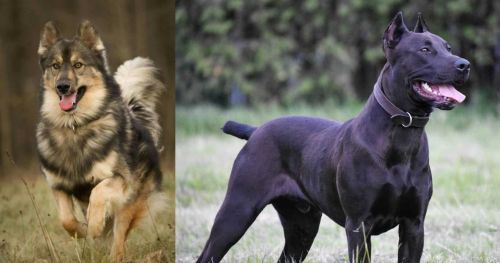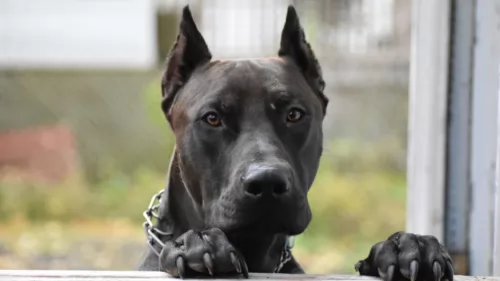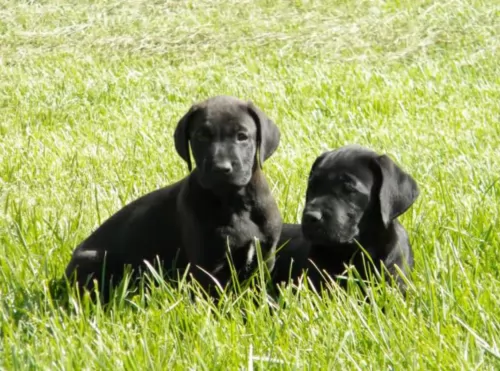 MyDogBreeds
MyDogBreeds Both Native American Indian Dog and Canis Panther are originated from United States. Native American Indian Dog may grow 43 cm / 16 inches shorter than Canis Panther. Native American Indian Dog may weigh 55 kg / 122 pounds more than Canis Panther. Native American Indian Dog may live 7 years more than Canis Panther. Native American Indian Dog may have more litter size than Canis Panther. Native American Indian Dog requires High maintenance. But Canis Panther requires Low maintenance
Both Native American Indian Dog and Canis Panther are originated from United States. Native American Indian Dog may grow 43 cm / 16 inches shorter than Canis Panther. Native American Indian Dog may weigh 55 kg / 122 pounds more than Canis Panther. Native American Indian Dog may live 7 years more than Canis Panther. Native American Indian Dog may have more litter size than Canis Panther. Native American Indian Dog requires High maintenance. But Canis Panther requires Low maintenance
 The Native American Indian Dog is an ancient breed, that some consider to be feral. It is a landrace breed that developed with the indigenous peoples North America. These dogs originally looked and sounded like wolves and it is likely that their ancestry is tied to wolves crossed with pre-Columbian American dogs that came to the America’s with the first peoples. There are some that believe the Native American Indian Dog is a connecting line back to the dogs or wolves that over 12,000 years ago were the first to be domesticated by human beings.
The Native American Indian Dog is an ancient breed, that some consider to be feral. It is a landrace breed that developed with the indigenous peoples North America. These dogs originally looked and sounded like wolves and it is likely that their ancestry is tied to wolves crossed with pre-Columbian American dogs that came to the America’s with the first peoples. There are some that believe the Native American Indian Dog is a connecting line back to the dogs or wolves that over 12,000 years ago were the first to be domesticated by human beings.
They are now a rare breed in the wild and a small group of domesticated dogs. Fossil studies in recent years suggests that the Native American Indian Dogs came to North America about 4500 years after the first indigenous peoples. It is believed that the Native Americans bred the dogs that traders and explorers brought with them to the native coyote as well. This created a breed specific to North America and called the Common Native Dog or the Common Indian Dog. The original NAID was a mix of many different breeds of dogs and wild canines.
Today’s NAID is said to be raised on Indian reservations in the United State and represent a mix of Chinook, Husky, German Shepherd Dog and Malamute, along with perhaps some of today’s wolf mixed in. This dog is raised domestically and is socialized to life with humans. They are the last remaining breed from all the Native North American dogs that lived with the original people of the Americas. They are also thought to have an ancestry similar to the Australian Dingo.
They are a devoted, protective and loyal breed though they tend to be shy. They need to be outside for the majority of the day and don’t do well in crates. They need a fenced yard and room to roam. They are working dogs that hunted, pulled sleds and guarded their homes. They still need a job to so.
Today the North American Indian Dog is being bred to replicate the temperament and appearance of the originals. Although there are many breeders working from the founding breeder with original stock, there are only six that are officially given authorization to breed the NAID. They are registered by Terra Pines with the National Kennel Club but not recognized by the AKC and UKC.
The breed name NAID is trademarked by Karen Markel of Majestic View Kennels in the 1990’s. Today the breed is nationally recognized as a breed very much like the original Native American dogs, The breed is intelligent and quite healthy. They enjoy people and engage in many companion activities.
Whatever its true ancestry the current Native American Indian Dog (NAID), today’s version is not recognized by the AKC, but they are recognized by the Dog Registry of America, the Native American Indian Dog Registry and the National Kennel Club.
 The Canis Panther is a strong, muscled dog who has been developed in the USA in the 1970s by Scorpio Jones, Michael Stratten, and Lucas Lopez. They mixed the Doberman Pinscher, the Great Dane the Labrador Retriever and the American Staffordshire Bull Terrier.
The Canis Panther is a strong, muscled dog who has been developed in the USA in the 1970s by Scorpio Jones, Michael Stratten, and Lucas Lopez. They mixed the Doberman Pinscher, the Great Dane the Labrador Retriever and the American Staffordshire Bull Terrier.
This dog hasn’t got a long history, having only been established in the 1970's, but the breeders wanted a dog much like the Doberman but somewhat larger and stronger. It is a dog breed which is still fairly unknown in the United States and elsewhere.
 There are two sizes of the North American Indian Dog – they are medium and large. They have dense short double coats, or they have long top coats and a fairly dense undercoat. They come in a variety of colors mostly black or silver but there is also a tortoiseshell. These tortoiseshell colored dogs are considered by Native Americans to be sacred beings. These tortoiseshell dogs are strikingly good looking and are called Spirit Dog.
There are two sizes of the North American Indian Dog – they are medium and large. They have dense short double coats, or they have long top coats and a fairly dense undercoat. They come in a variety of colors mostly black or silver but there is also a tortoiseshell. These tortoiseshell colored dogs are considered by Native Americans to be sacred beings. These tortoiseshell dogs are strikingly good looking and are called Spirit Dog.
They all have the look of a Siberian Husky or Alaskan Malamute with upright ears and almond shaped eyes that are anywhere from amber to brown with some blue. Usually their tails are down and long but can be curled. They resemble the wolf and have that wild, feral appearance. They can be as large as over one hundred pounds or average seventy to eighty pounds. They are strong, alert and intelligent. They are considered to be hypoallergenic, shedding their coat only once a year.
 The Canis Panther is a large dog measuring roughly 68 – 77 cm in height and weighing around 50 to 63 kg. He has a deep chest and strong neck. The coat is short and dense and it is is essentially a solid color - fawn, grey, blue, chocolate or black.
The Canis Panther is a large dog measuring roughly 68 – 77 cm in height and weighing around 50 to 63 kg. He has a deep chest and strong neck. The coat is short and dense and it is is essentially a solid color - fawn, grey, blue, chocolate or black.
He looks magnificent with his cropped ears and short docked tail. Unfortunately with regulations surrounding the docking of dog’s tails, the dog these days is often left with a long tail.
He is an intelligent, territorial dog and makes an excellent watchdog. He is a dog which can be easily trained and socialized and then he makes a great family dog. He is loving and loyal to his human family, being somewhat aloof with strangers. His gets along well with children in the home as well as with other pets.
 This breed is gentle and loving with children.
This breed is gentle and loving with children.
Endurance, strength and good health.
Low adaptability to small living spaces and lack of outside space; don’t do well in crates and need an experienced dog owner.
They are highly intelligent, love to learn and are just a little stubborn.
 The Canis Panther is a loving dog in spite of his large, guard-dog looks. He is intelligent, bold and courageous, and when trained and socialized is a devoted, loyal, loving pet.
The Canis Panther is a loving dog in spite of his large, guard-dog looks. He is intelligent, bold and courageous, and when trained and socialized is a devoted, loyal, loving pet.
He is known for his high intelligence and becomes so attached to his human family he will fight to the death for them if needs be. He is a territorial dog and won’t welcome strangers to his door.
The Canis Panther puppy is outgoing and playful, loving the company of kids in the family.He requires a firm owner who can see to it that he gets in a good quota of exercise. He is an energetic dog and if he isn’t given enough exercise he can become destructive and aggressive through no fault of his own but because of an irresponsible owner.
The Canis Panther is a large dog but given love and proper care he becomes the most awesome, strong devoted pet and protector.
 This is a fairly healthy, long lived breed having spent so much of its history in isolation. They are prone to some of the issues that affect all medium to large breeds.
This is a fairly healthy, long lived breed having spent so much of its history in isolation. They are prone to some of the issues that affect all medium to large breeds.
 The Canis Panther breed is not known to have any particular illness and he can live to be 10, 11 or 12 years of age. However, like every other dog, there are some more common dog illnesses that you will need to be aware of and which are seen more commonly in larger dog breeds, some of which are -
The Canis Panther breed is not known to have any particular illness and he can live to be 10, 11 or 12 years of age. However, like every other dog, there are some more common dog illnesses that you will need to be aware of and which are seen more commonly in larger dog breeds, some of which are -
Larger breeds can be prone to bone cancer, known as Osteosarcoma and found more often in the limbs. Dogs develop swelling in the affected part of the limb and the bones can break easily. If you notice swelling or limping, see that you get your pet to the vet.
This is another kind of cancer which affects the Lymphocytes, a type of white blood cell. Dogs with Lymphoma may have an enlarged lymph node under the chin and neck for instance or the swelling could be in the groin area. Get your dog to the vet so as to have the lump biopsied.
 Because of their propensity to grow to quickly the puppy should only stay on puppy food for 8-10 months. Feed them a high quality large dog puppy food 3-4 times daily for a total of 2-21/2 cups per day.
Because of their propensity to grow to quickly the puppy should only stay on puppy food for 8-10 months. Feed them a high quality large dog puppy food 3-4 times daily for a total of 2-21/2 cups per day.
Feed a high protein, large dog dry food twice a day for a total of two cups. Do not over feed. Do not feed right before or after exercise do to the risk of bloat.
Healthy, strong long lived dog.
This is not an indoor, couch potato dog. They need exercise and they need space. They won’t do well as apartment dogs unless you can take them to a dog park for over an hour every day. They really need a large fenced in yard. They don’t do well in crates either. He doesn’t understand crates and thinks you are punishing him. They make great hunters, search and rescue dogs, service dogs and therapy dogs. They will succeed at pulling competitions and weight competitions.
 With his short coat, the Canis Panther is looked upon as a low mainenance dog. You’ll need to brush his hair at least twice a week though to remove loose hairs and keep the coat shiny.
With his short coat, the Canis Panther is looked upon as a low mainenance dog. You’ll need to brush his hair at least twice a week though to remove loose hairs and keep the coat shiny.
Brush your pet’s teeth at least 2 or 3 times a week. You get special toothpaste and toothbrush for dogs and your vet can guide you on how to use them. If you don’t attend to your pet's teeth, he can experience tartar build up. This can lead to gum disease and tooth loss. Not only that, bad teeth can affect other parts of the body too.
This breed comes from several large dog breeds and as a big dog, he is certainly going to need a good deal of exercise. He’ll need a walk every day or perhaps frisbee games in the park where he is made to run.
Any dog requires exercise, and especially a magnificent dog like this one. You want to make sure you maintain those lean, muscled limbs by ensuring he gets his fair share of exercise.